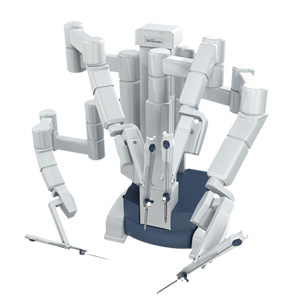
Robotic and laparoscopic techniques allow the kidney to be removed using key-hole incisions in the abdomen. Occasionally 1 or 2 additional retraction ports may be required. Conversion to the standard open operation is easily accomplished, should technical difficulty be encountered.
Laparoscopic surgery uses hand-held key-hole instruments while the robotic surgery provides a 3-D magnified view with wristed instruments that are easier to move than standard hand-held key-hole instruments. A standard laparoscopic approach using the hand held keyhole instruments is sufficient for a radical nephrectomy. In comparison, a partial nephrectomy is much more complex and so using the robot can arguably help make the operation easier to perform.
A video on robotic surgery can be seen below. This video relates to a prostate operation. However, the robot can also be used for kidney surgery and the video demonstrates how the robot works.
Advantages of Robotic and Laparoscopic Surgery
The main advantage of robotics and laparoscopy are the reduction in pain and post-operative recovery time. Patients can usually mobilise unassisted two days post-op and are often ready for discharge at that time. Patients receiving the open operation usually cannot walk until day 4 or 5 and are not ready for discharge until a week or 10 days after surgery.
Most patients after robotic and laparoscopic kidney surgery are able to return to normal activities by the end of the first week, while patients after the open operation usually take 6 to 8 weeks. After a partial nephrectomy, patients should avoid strenuous physical activity for 12 weeks while the kidney heals.
Recent results from multi-centre trials have shown robotic and laparoscopic kidney surgery to be safe in the treatment of localised renal cancer, hence widening the indication for the operation.
Disadvantages of Laparoscopic Nephrectomy
This operation is technically demanding and is associated with a steep learning curve. The operating time is longer than open operation, although with experience this reduces significantly.
Problems associated with CO2 distension of the abdomen can cause problems such as shoulder pain, CO2 retention, possible embolisation and tumour spillage, which have not occurred in renal cell carcinoma.




